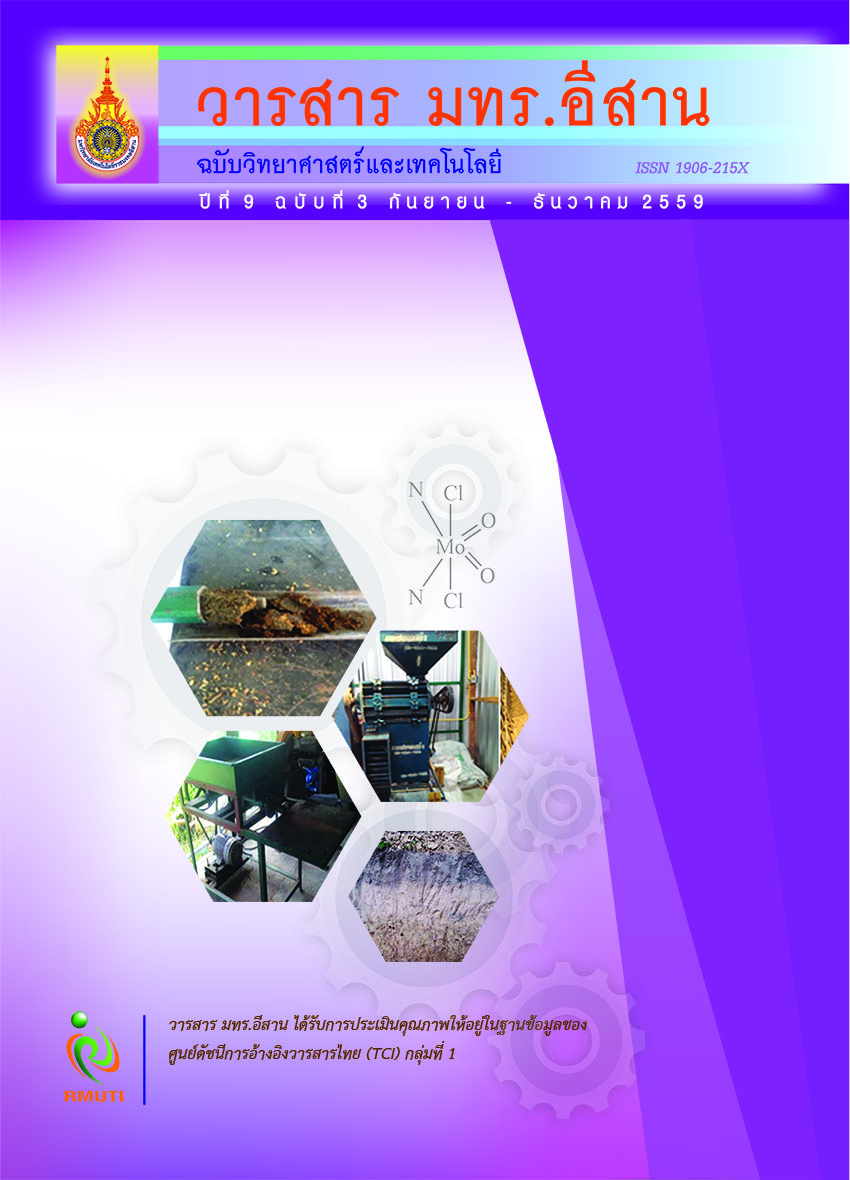ประสิทธิภาพของระบบพืชกรองน้ำ รว่ มกับเครื่องกลเติมอากาศในการบำบัดน้ำเสีย จากพื้นที่โครงการพัฒนาดอยตุง (พื้นที่ทรงงาน) อันเนื่องมาจากพระราชดำริ Efficiency of Wastewater Treatment using a Combination System of Plantbed Filter and Aerators from Doi Tung Deve
Main Article Content
Abstract
บทคัดย่อ
งานวิจัยนี้มีวัตถุประสงค์เพื่อศึกษาประสิทธิภาพของระบบพืชกรองนํ้า ร่วมกับเครื่องกลเติมอากาศในการ
บำบัดนํ้าเสีย จากพื้นที่โครงการพัฒนาดอยตุง (พื้นที่ทรงงาน) อันเนื่องมาจากพระราชดำริในการลดค่า
ของแข็งแขวนลอย บีโอดี ซีโอดี แอมโมเนียไนโตรเจน ไนเทรต และออร์โธฟอสเฟต จากนํ้าเสียโรงงาน
ฟอกยอ้ มและโรงงานกระดาษสา อัตราการไหลของน้ำเสียเขา้ ระบบ 31.2 ลิตรตอ่ วัน หรือ 22 มิลลิลิตรตอ่ นาที
ทดลองกับระบบบำบัดนํ้าเสีย 4 รูปแบบ ได้แก่ ระบบเติมอากาศ ระบบรางพืชร่วมกับระบบเติมอากาศ
ระบบรางพืช และพืชลอยนํ้าร่วมกับระบบเติมอากาศด้วยเครื่องเติมอากาศ 2 เครื่อง และระบบรางพืช
และพืชลอยน้ำรว่ มกับระบบเติมอากาศ ดว้ ยเครื่องเติมอากาศ 1 เครื่อง ผลการทดลองพบวา่ ระบบรางพืช
และพืชลอยนํ้าร่วมกับระบบเติมอากาศ ด้วยเครื่องเติมอากาศ 2 เครื่อง มีประสิทธิภาพในการบำบัด
นํ้าเสียได้ดีที่สุดโดยมีประสิทธิภาพการกำจัดของแข็งแขวนลอยทั้งหมด บีโอดี ซีโอดี ออร์โธฟอสเฟต
แอมโมเนียไนโตรเจน และแอมโมเนียไนเตรต มีค่าร้อยละ 61.34 ± 8.26 92.48 ± 3.72 67.71 ± 9.14
-49.27 ± 33.93 52.62 ± 9.17 63.21 ± 15.45 ตามลำดับ
Abstract
This research investigates the efficiency of wastewater treatment from Doi Tung
development project: Mae Fah Luang Foundation Under Royal Patronage for Total
Suspended Solid (TSS), Biochemical Oxygen Demand (BOD5), Chemical Oxygen Demand
(COD), ammonia nitrogen (NH4
+-N), nitrate (NO3
--N), and orthophosphate (PO4
3-) removal
using a combination system of planted filter and aerators. The flow rate of 31.2 Ld-1
(22 mLmin-1) was fed to the four plug flow treatment systems. Such treatments were the
aerator systems, hybrid system between planted bed filter and aerators, hybrid system
between planted bed filter, floating plant and 2 aerators and hybrid system between
planted bed filter, floating plant and 1 aerators. The test results showed that the hybrid
system combining planted bed filter, floating plant and 2 aerators had the best
performance. An improvement of TSS by 61.34±8.26%, BOD by 92.48±3.72%, COD by
67.71±9.14%, PO4
3- -49.27±33.93%, NH4
+ -N 52.62±9.17%, and NO3
--N 63.21±15.45 % can
be obtained.
Article Details
References
[2] Hammer, D. A. (1989). Constructed Wetlands for Wastewater Treatment: Municipal. Industrial and Agricultural. CRC Press
[3] US Army Corps of Engineering. (1993). Selection and Acquisition of Wetland Plant Species for Wetland Management. (No. project. VN-EM-2.1). Vicksburg: US Army Corps of Engineering
[4] Cincinnati, O. (n.d.). (2014). NEPIS Document Display. Access (27 May 2014). Available (https://nepis.epa.gov/Exe/ZyNET.exe/30004TBD.TXT)
[5] Cooper, P. F., Job, G. D., Green, M. B. and Shutes, R. B. E. (1996). Reed Beds and Constructed Wetlands for Wastewater Treatment. Swindon: WRc Publications.
[6] H. Brix. (1994). Functions of Macrophytes in Constructed Wetlands. Water Science and Technology. Vol. 29. No. 4. pp 71-78
[7] Vymazal, J. (2011). Plants Used in Constructed Wetlands with Horizontal Subsurface Flow: s Review. Hydrobiologia. Vol. 674. No. 1. pp. 133-156
[8] Wood, J., Fernandez, G., Barker, A., Gregory, J. and Cumby, T. (2007). Efficiency of Reed Beds in Treating Dairy Wastewater. Biosystems Engineering. Vol. 98. No. 4. pp. 455-469
[9] Zhao, Y., Sun, G. and Allen, S. (2004). Purification Capacity of a Highly Loaded Laboratory Scale Tidal Flow Reed Bed System with Effluent Recirculation. Science of The Total Environment. Vol. 330. Issue 1-3. pp. 1-8
[10] Calheiros, C. S. C., Duque, A. F., Moura, A., Henriques, I. S., Correia, A., Rangel, A. O. S. S. and Castro, P. M. L. (2009). Substrate Effect on Bacterial Communities from Constructed Wetlands Planted with Typha Latifolia Treating Industrial Wastewater. Ecological Engineering. Vol. 35. No. 5. pp. 744-753
[11] Mbuligwe, S. E. (2005). Comparative Treatment of Dye-Rich Wastewater in Engineered Wetland Systems (EWSs) Vegetated with Different Plants. Water Research. Vol. 39. Issue 2-3. pp. 271-280
[12] R.K. Wieder. (1989). A Survey of Constructed Wetlands for Acid Coal Mine Drainage Treatment in the Eastern United States. Wetlands. Vol. 9. pp. 299-315
[13] Bulc, T. G. and Ojstr ek, A. (2008). The Use of Constructed Wetland for Dye-Rich Textile Wastewater Treatment. Journal of Hazardous Materials. Vol. 155. Issue 1-2. pp. 76-82
[14] Wu, S., Kuschk, P., Brix, H., Vymazal, J. and Dong, R. (2014). Development of Constructed Wetlands in Performance Intensifications for Wastewater Treatment: A nitrogen and Organic Matter Targeted Review. Water Research. Vol. 57. pp. 40-55
[15] The Chaipattana Foundation. (n.d.). Improve Water Quality in the Area Rail System. Access (15 July 2014). Available (https://www.chaipat.or.th/chaipat/index.php/th/-plantbed-filter/5825-2013-05-29-17-24-36)
[16] APHA, AWWA and WEF. (2005). Standard Methods for the Examination of Water and Wastewater. (21st ed.)
[17] Royal Gazette. (2010). Announcement of Pollution Control Department: The Design
Criteria of Wastewater Collection System and Sewage System of the Community.
No. 127:72
[18] Faulwetter, J. L., Gagnon, V., Sundberg, C., Chazarenc, F., Burr, M. D., Brisson, J. and Stein, O.R. (2009). Microbial Processes Influencing Performance of Treatment Wetlands: A review. Ecological Engineering. Vol. 35. No. 6. pp. 987-1004
[19] Kadlec, R. H. and Wallace, S. (n.d.). (2015). Treatment Wetlands. (2nd ed.). Boca Raton, FL., USA
[20] Austin, D. and Nivala, J. (2009). Energy Requirements for Nitrification and Biological Nitrogen Removal in Engineered Wetlands. Ecological Engineering. Vol. 35. No. 2. pp. 184-192
[21] Nivala, J., Hoos, M. B., Cross, C., Wallace, S. and Parkin, G. (2007). Treatment of Landfill Leachate Using an Aerated, Horizontal Subsurface-Flow Constructed Wetland. Science of The Total Environment. Vol. 380. Issue 1-3. pp. 19-27
[22] Nivala, J., Wallace, S., Headley, T., Kassa, K., Brix, H., van Afferden, M. and M ller, R. (2013). Oxygen Transfer and Consumption in Subsurface Flow Treatment Wetlands. Ecological Engineering. Vol. 61. Part B. pp. 544-554
[23] Brix, H. and Schierup, H.-H. (1989). The Use of Aquatic Macrophytes in Water-Pollution Control. Ambio. Vol. 18. pp. 100-107
[24] Ouellet-Plamondon, C., Chazarenc, F., Comeau, Y. and Brisson, J. (2006). Artificial Aeration to Increase Pollutant Removal Efficiency of Constructed Wetlands in Cold Climate. Ecological Engineering. Vol. 27. No. 3. pp. 258-264
[25] Vymazal, J. (2007). Removal of Nutrients in Various Types of Constructed Wetlands. Science of The Total Environment. Vol. 380. Issue. 1-3. pp. 48-65
[26] Petticrew, E.L. and Kalff, J. (1992). Water Flow and Clay Retention in Submerged Macrophyte Beds. Canadian Journal of Fisheries and Aquatic Sciences. Vol. 49. No. 12. pp. 2483-2489
[27] Gumbricht, T. (1993a). Nutrient Removal Capacity in Submersed Macrophyte Pond Systems in a Temperate Climate. Ecological Engineering. Vol. 2. pp. 49-61
[28] Gumbricht, T. (1993b). Nutrient Removal Processes in Freshwater Submersed Macrophyte Systems. Ecological Engineering. Vol. 2. pp. 1-30


